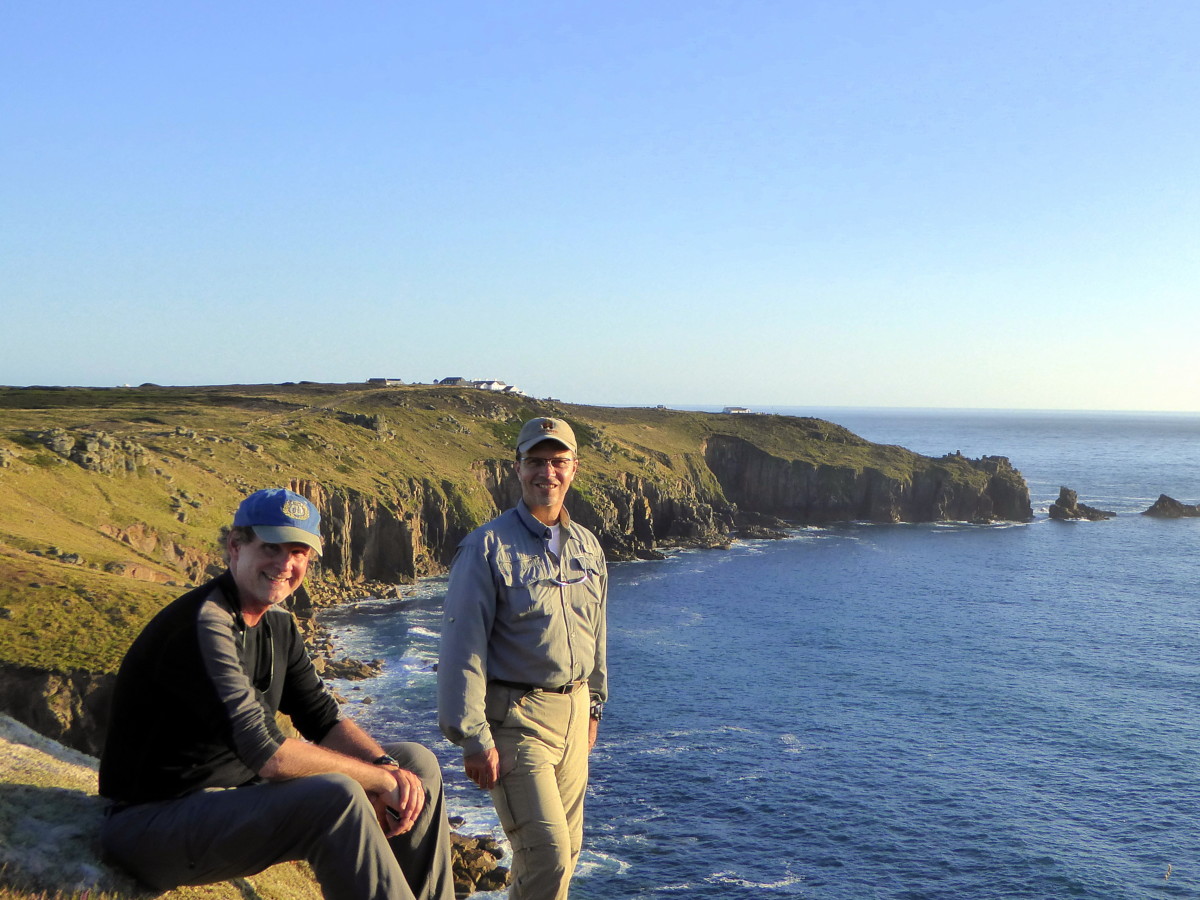
Saturday, August 15, 2015
By Dan Friesen
I just returned today from Cornwall and Wales; friend and fellow guide Scott Burk was with me for the first two weeks of a three week journey and did a fabulous job of driving the winding backroads of Great Britain. After Scott returned to the US, however, I then drove the final week alone. We experienced a lot more than the highways and byways of Great Britain. I have to say, however, that driving in this part of the world was a constant sub-theme each and every day. I’ve driven in a lot of places, including several where the practice is to drive on the left – South Africa, New Zealand, Australia, and Ireland, to name a few. And I’ve driven in Great Britain, though it’s been over ten years. Cornwall, however, seems to have it’s own special niche in the category of most challenging places to drive – much of it having to do with the last tip in this post.
Though it’s a bit tongue in cheek, perhaps these recollections, and suggestions, will be a factor to keep in mind as you read posts about our out-of-car experiences that follow. Fresh off a 13 hour flight from London, by way of Amsterdam, here are a few tips for those considering a self-drive trip through Great Britain.
Invest in a GPS
Driving through Great Britain is overly challenging for an American due to a disorienting economy of street signs in towns, circuitous roads, and towns and villages not identified by conspicuous signs upon entry and exit as they are in most countries on the continent. All this is amplified by the general “foreignness” of driving out of country and especially magnified by everything about the driving experience being reversed directionally – left and right. NOTE: Google maps on smartphones have made GPS’s somewhat of an anachronism when you are driving in your own country. But because data service on smartphones is still prohibitively priced out of country, an GPS is probably the best way to navigate in Great Britain.
Develop a good relationship with your GPS
You’ll be spending a fair bit of time listening to that voice, usually a female unless your GPS gives you options, so consider giving it a name. I called mine “Daphne”. Develop a healthy skepticism of your Daphne. Love her unconditionally but don’t obey her every command. Take a look at an old fashioned paper map to see if Daphne is taking you in a general direction that makes sense.
Think Left and Look Right!
Left side of road, shifting with left hand, left hand blinker, rear-view mirror on the left. But you must look right first, rather than left first, when you are turning or merging into traffic. Traffic being in the opposite lane means your instincts of where to look first, when gauging the timing of your turn, are backwards. This is a big deal!
Perfect the Duck, Dart, & Drive Dance
In towns and villages, 2-lane roads almost always double as parking space. Old World roads were not designed for motorized traffic and two lanes of relatively high speeds of traffic. People didn’t necessarily park their wagons out on the road. In the age of the automobile, parking space is at a premium and everyone is accustomed to sharing driving lanes with parked cars. If parked cars are on your side of road, you must be prepared to yield to oncoming traffic. In this case, oncoming traffic has right of way. I call it the Duck, Dart, & Drive Dance. You need to Duck behind cars parked on your side of the road, then Dart out and Drive quickly to get through the restricted lane to the next open space before the next oncoming car claims right of way. This dance goes back and forth depending upon which side of the road cars are parked.
GPS Shortcut Warning
Daphne is fanatically committed to finding the shortest distance between 2 points, which on Old World roads is never a straight line. Be aware that this shortest distance is often not in your best interest because Daphne doesn’t know the width of the road and how much of its distance is really only one lane being used by 2-lanes of traffic. Never follow Daphne’s directive to drive down a road or lane that looks suspiciously narrow or has that “shortcut” feel to it. (see Hedgerow Heaven below).
If you have time to “plot your course” in at least a general way on the paper map, ignore her directives to use minor farm roads and listen as the she goes through her “recalculating” mantra. Unless you are pretty sure that your destination is buried somewhere back in those hedgerows, stay on a more primary road and see what other routing ideas Daphne has.
Roundabout Roulette
One of Great Britain’s most ingenious contributions to the Modern Age is undoubtedly the “roundabout”. It probably follows that the Brits would excel in circular road design given the almost universal lack of right angles in their network of roads and highways. But roundabouts, once you acclimate to them, are a wonderful way to change direction without having to stop. There is a protocol to follow however. Anticipate which roundabout exit you will use so that you are in the proper lane to enter the roundabout. You can foul up the works if you do it wrong, and the whole point of the roundabout is to keep traffic moving, so you don’t exactly have a chance to stop and sort it out before plunging into the flow.
Eyes in the Back of Your Head?
Practice using peripheral vision to gauge clearances on both sides when clearances are limited. Because Americans are “spoiled for space”, clearances seems ridiculously tight in almost every phase of driving in Great Britain and you need to be watching BOTH sides of the car. Be prepared to slice so close to oncoming drivers that you can smell their aftershave (or perfume)…even with the windows up. Having been a Lamaze coach for Linda during the births of our five children, I found Lamaze breathing techniques helpful in keeping me alert and aware and ready to make micro-adjustments when a whiff of the next drivers aftershave or perfume alerted me to another narrow encounter. Ironically, there’s a not-to-indistinct resemblance between navigating through narrow, hedgerow-lined lanes and the squeeze of a new life coming through the birth canal to find the light at the end of the tunnel.
Hedgerow Heaven…or NOT!?
Much of Great Britain is delightfully rural. The placid, picturesque panoramas of driving through the British countryside are unrivaled for this type of, bucolic farmland ambiance. Old World transportation lanes developed, however, along the course of least resistance, conforming to the contours of terrain. Engineers had not the means or technology to tunnel and bridge, and blast away hillsides to straighten out roads. Furthermore, British farming practices of using hedgerows as boundaries between fields is often applied as well to the boundary between the fields and the road. The product of hedgerows, narrow roads, and winding roads produces a frightening result for the foreign driver.
The metaphor of the “maze” or “labyrinth” might be a bit overdone, but to me it portrays the feeling one gets on such roads. Often the two-sided maze is formed by mature trees that have grown to become a complete tunnel, and a lack of light is added to the challenging variables. Two lane traffic was not a priority when boundary lines were set and hedgerows planted. Distressingly high percentages of country roads, particularly, in my experience, in Cornwall and southwest England, are really one-lane wide, one very narrow lane that abuts directly against a hedgerow or a stone wall with zero, absolutely zero, shoulder. The concept of buffer space or what we call the “shoulder” of the road seems unnecessary to British drivers. Their ability to maneuver exceedingly tight tolerances is nothing short of phenomenal!
On such roads, you will frequently find yourself playing the proverbial nerve-wracking driving game of “chicken”, with no discernible right-of-way guidelines. Whoever seems to have the closest wide spot behind them generally backs up. Of course, larger vehicles tend to claim right of way due to the difficulty they have backing up. Be mentally prepared to back up in narrow lanes when oncoming traffic dictates; keep mental tabs of wide spots in road so you know how far back to go to allow room.
The most extreme example of this came after Scott had returned home and I was both driver and navigator. I left a lovely country guesthouse I overnighted in, discovered the evening before after snaking my way through one of the denser sections of hedgerow maze I’d yet seen. Next morning as Daphne was finding our way back out of the maze, I rounded a corner of the labyrinth and found myself headlights to headlights with a full size semi-truck and trailer. I kid you not! It was a true “Depends” moment and had I not been in a full blown panic mode (he was NOT backing up), I would have snapped a quick photo as proof of the incredulous ridiculousness of the situation. You had to be there to believe it – that a massive truck with a plethora of axles and length, and probably less than a foot of clearance on both sides, would force its way through such a dense two-way maze. I put the car in reserve and backed up…up hill…for about 100 yards until I found a driveway to pull into. I then hyperventilated for a few minutes, found a fresh set of undergarments in my luggage, and released Daphne to attempt the maze once more!
*****************************************************************************************************
All this may sound like a strong endorsement to take a bus tour like the one we’ve been planning, rather than exploring Wales and Cornwall on your own, and if that is the conclusion you reach, I’d say it’s a good one. Honestly though, this is a delightful part of Great Britain, and the back country moments and narrow country lanes are one of the charms, that become one of its challenges when you get behind the wheel (on the right side of the car)!

